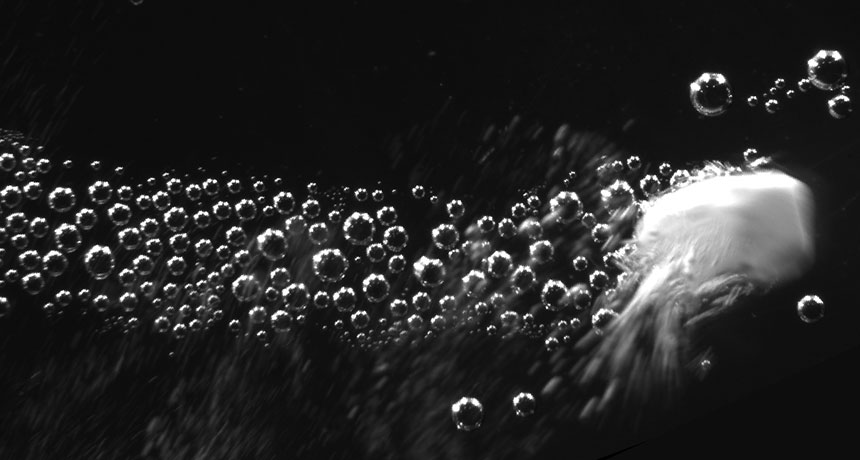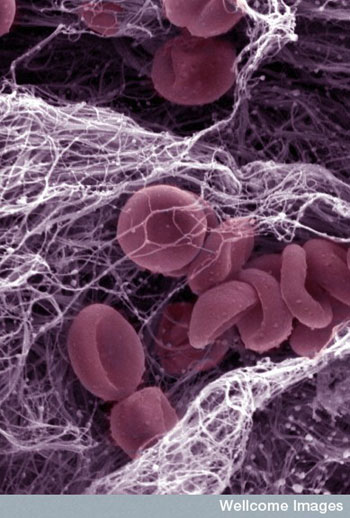These bubbles treat wounds
A fizzy mixture can carry blood-clotting drugs upstream into wounds to stop bleeding

A fizzing chemical mixure rushes through a liquid, leaving a jet of bubbles behind. This action could help stop bleeding by carrying blood-clotting drugs to seal shut wounds.
James Baylis
By Meghan Rosen
Jets of fizzy bubbles can carry blood-clotting drugs deep into a wound and seal it shut, a new study shows.
The bubble-powered drugs could come in handy in a car accident, in bleeding after childbirth or even on the battlefield, says Christian Kastrup. He works at Canada’s University of British Colombia in Vancouver. His team reported its new findings October 2 in Science Advances.
This work is the first to show bubble-powered devices doing something useful inside the body, says Jan van Hest. An organic chemist, he works at Radboud University in Nijmegen, the Netherlands. “What they’ve done is really clever,” says Van Hest, who wasn’t involved in the study.

For small injuries, blood can clot, turning into a gel that glues damaged tissue together. But blood can’t plug large wounds on its own, Kastrup says. “You have to come up with ways to get in there and help the blood clot.” Clot-promoting drugs exist. But it’s not easy to deliver them deep into a wound. That’s because they would have to travel upstream against flowing blood.
Ayusman Sen is a chemist at Pennsylvania State University in State College. Scientists have devised all sorts of ideas for high-tech gizmos that could carry drugs through the body, he notes. But it would be even better to find a way to get drugs to deliver themselves, Sen says. And that’s what Kastrup’s team has done.
They created a kind of chemical powder keg loaded with blood-clotting drugs. When the keg touches a wound, it triggers tiny explosions. These release bubbles of carbon dioxide gas. And they blast the drugs in all directions — including into damaged tissues.
These bubble-propelled drugs seem to help injured mice and pigs.
In one test, Kastrup and his colleagues snipped tips off of the tails of nine mice. Then they sprinkled the wound with a powdered blend of three ingredients. The first is calcium carbonate. (That’s the main ingredient in some candy-like antacids, such as Tums.) The second ingredient is an organic acid, used to essentially turn on the calcium carbonate. The third is a drug, called thrombin. It causes blood to clot. Seven of nine treated mice stopped bleeding within 10 minutes. When the team repeated the experiment using only the blood-clotting thrombin (and no bubbles to carry it upstream), only three of nine mice stopped bleeding.
Next, the researchers tested the powder mix against a more severe injury. They surgically punched a hole about the size of a pencil eraser in the femoral arteries of pigs. Femoral arteries are major conduits carrying blood to the legs. With no treatment, the pigs bled out and died within three hours. But all pigs treated with the drugged bubbles survived.
“In an emergency, it would be nice to have this powder in a first aid kit,” van Hest says. “Even if you’re not an expert medic, you could put the powder on a wound to make it stop bleeding.”
Sen agrees that the fizz is a nice way to deliver drugs, but says those drugs would be even more effective if they zeroed in on the wound. “The particles are going every which way,” he says. “In the future, you need something that’s better directed.”

Educators and Parents, Sign Up for The Cheat Sheet
Weekly updates to help you use Science News Explores in the learning environment
Thank you for signing up!
There was a problem signing you up.
Power Words
(for more about Power Words, click here)
acid A chemical that increases the level of hydrogen ions in a solution.
antacid A medicine used to neutralize acids in the stomach.
calcium carbonate The active ingredient in some antacid medicines (ones used to neutralize stomach acids). Its formula is CaCO3 (meaning it contains one calcium atom, one carbon atom and three oxygen atoms). Calcium carbonate is the main chemical compound in limestone.
carbon dioxide A colorless, odorless gas produced by all animals when the oxygen they inhale reacts with the carbon-rich foods that they’ve eaten. Carbon dioxide also is released when organic matter (including fossil fuels like oil or gas) is burned. Carbon dioxide acts as a greenhouse gas, trapping heat in Earth’s atmosphere. Plants convert carbon dioxide into oxygen during photosynthesis, the process they use to make their own food. The abbreviation for carbon dioxide is CO2.
clot (in medicine) A collection of blood cells (platelets) and chemicals that collect in a small region, stopping the flow of blood.
chemistry The field of science that deals with the composition, structure and properties of substances and how they interact with one another. Chemists use this knowledge to study unfamiliar substances, to reproduce large quantities of useful substances or to design and create new and useful substances. (about compounds) The term is used to refer to the recipe of a compound, the way it’s produced or some of its properties.
femoral artery A major blood vessel in the thigh that carries blood from the heart to the tissues of the leg.
fibrin A fibrous protein that works to form a mesh that holds blood platelets in place over an open wound until a clot forms.
fibrinogen A protein made in the liver that then circulates in the blood. When a wound develops, this protein is transformed to fibrin — a fiber-like protein that helps make a mesh to hold platelets in place, forming a clot.
organic (in chemistry) An adjective that indicates something is carbon-containing; a term that relates to the chemicals that make up living organisms.
thrombin An enzyme that helps promote the clotting of blood by converting fibrinogen into fibrin.







